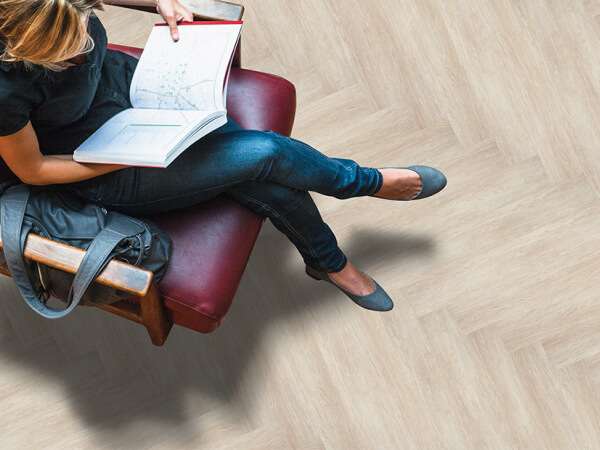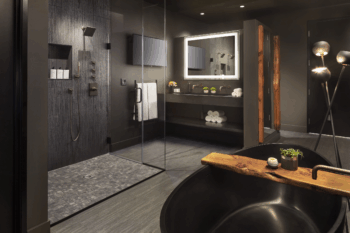4 Trends to Boost Your Store Interior Design
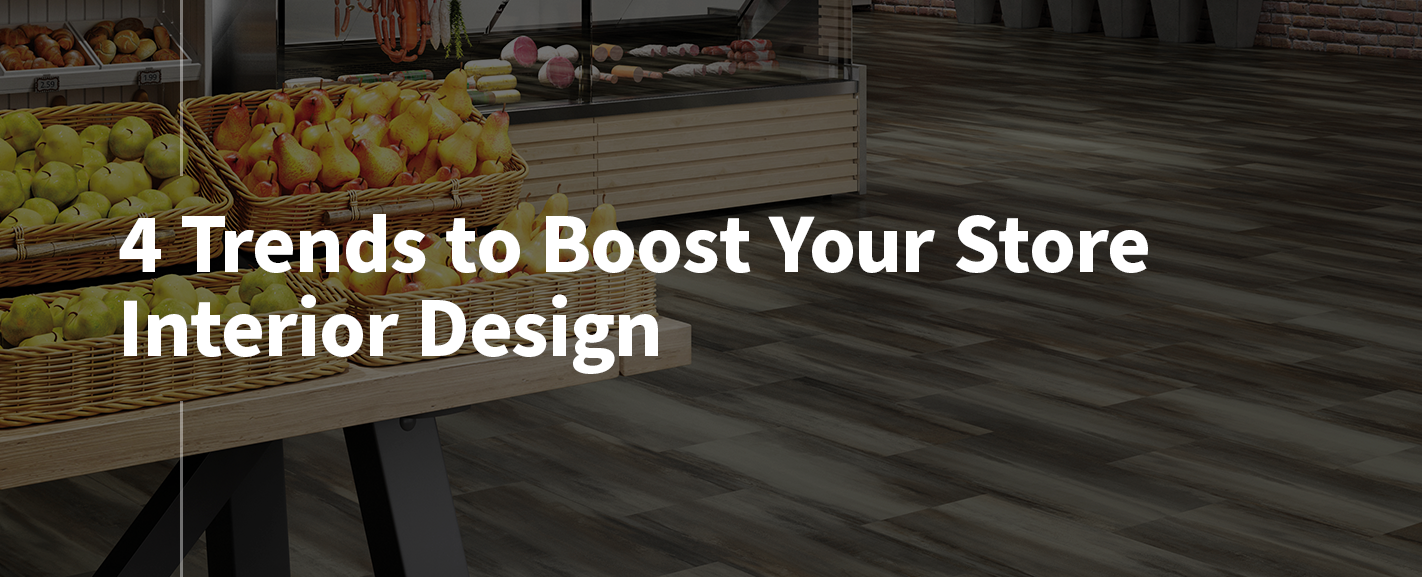
As customer preferences shift and competition tightens, retail spaces must do more than look good—they need to offer a shopping experience that’s seamless, immersive, and memorable. Retailers and designers are tasked with creating environments that not only capture attention but also stand up to the demands of daily use.
From moving displays and high foot traffic to maintaining cleanliness and preventing slips, the flooring and design choices you make need to work just as hard as the store itself. Luxury vinyl tile (LVT) offer the versatility, durability, and aesthetic appeal required to achieve this balance, helping retailers stay ahead in today’s fast-changing marketplace.
In this post, we’ll explore four key trends shaping retail store design in 2025 and how interior designers and architects can use them to create standout spaces that attract and engage shoppers.
Store Interior Design Trends for 2025
Retail Store Design Trend #1: Top Colors & Textures
Retail Store Design Trend #2: Biophilic Design
Retail Store Design Trend #3: Flexible Store Layouts
Retail Store Design Trend #4: Acoustic Considerations
How to Incorporate Retail Design Trends in 2025
The Next Chapter in Retail Store Design
Store Interior Design Trends for 2025

The 2025 retail design landscape focuses on creating spaces that captivate customers while ensuring the operational aspects of the store run smoothly. This year’s trends reflect a deep understanding of both the visual impact and the practical needs of retail environments. LVTprovides the ideal balance between aesthetics and functionality, addressing everything from heavy foot traffic to ease of maintenance.
Modern retailers often prioritize the following:
- Welcoming atmosphere: Creating an inviting, warm space encourages longer customer visits and repeat shopping experiences. Materials like luxury vinyl flooring, which offer soft textures and visually appealing finishes, help set the mood for a more comfortable and engaging retail environment.
- Brand identity: Design plays a vital role in communicating a brand’s personality. Consistency in the use of colors, textures, and patterns ensures that the brand message is clear and aligned with the company’s values. Whether it’s through sleek stone looks or warm wood tones, flooring choices help reinforce brand identity while offering the durability needed for busy spaces.
- Product spotlights: Innovative displays and lighting techniques are often used to showcase key products, but flooring can enhance the overall experience as well. Strategic placement of LVTcan define product zones, drawing attention to featured items while ensuring safety and comfort during the shopping experience.
- Space optimization: Efficiently utilizing space is critical in today’s retail environments. Flooring solutions like LVTcan handle the constant movement of modular displays and heavy foot traffic, offering scratch-resistant surfaces that maintain their appearance over time. The ability to clearly zone areas and streamline foot traffic enhances the overall shopping flow, ensuring customers have a seamless experience.

The store interior design trends emphasize the importance of both visual appeal and functionality. With adaptable, durable materials like LVT, retailers can create spaces that are easy to maintain while offering an aesthetic that resonates with today’s customers.
Retail Store Design Trend #1: Top Colors & Textures

Color and texture are essential tools in shaping the mood, setting the tone, and telling a brand’s story. In 2025, rich, warm tones and bold textures take center stage, offering an immediate visual impact and an inviting feel to retail spaces. To this end, luxury vinyl tile’s diversity in design and textures gives store designers the flexibility to embrace their brand’s aesthetic while staying within budget.
- Warmer wood tones: Warm, honey-colored wood-look flooring continues to dominate, with smoother textures adding a touch of natural luxury. These tones create an inviting, organic feel, making spaces look polished without feeling overly formal. Rift – Honey from our 2-3-5 Luxury Vinyl Plank & Tile collection offers natural textures and smooth graining, bringing depth and authenticity to retail environments. Another excellent choice is Camelback from the TAJ Select collection, which combines high performance and affordability while delivering the warmth and richness of wood.
- Concrete and stone designs: Concrete and stone visuals are becoming increasingly popular for their sleek, industrial feel, grounding a space and creating a strong foundation for other design elements. Products like Gunmetal from the Select collection, and our Native selection like Pebble or Sand from the TAJ 2-3-5 collection offer high-performance solutions with modern stone and concrete visuals, making them ideal for stores that want a stylish, durable finish. These tiles, available in various sizes and thicknesses, balance a contemporary look with resilience to withstand heavy foot traffic.
- Terrazzo style: Bold patterns are making a comeback, and terrazzo visuals are a key part of this trend. Terrazzo luxury vinyl tile, such as Dark or Light from the 2-3-5 Luxury Vinyl Plank & Tile collection, delivers a large-scale visual that blends the look of chipped marble, quartz, and granite. Available in multiple thicknesses and sizes, these tiles offer not only striking visuals but also practical features like acoustic solutions and application versatility, making them perfect for high-traffic commercial spaces.
Retail Store Design Trend #2: Biophilic Design

Biophilic design focuses on creating an immersive, nature-inspired environment. In retail spaces, biophilic elements appeal to customers’ senses while fostering a wellness-centered atmosphere that benefits both shoppers and employees.
- Living walls and greenery: Incorporating greenery through living walls or scattered plants creates a lush, refreshing atmosphere. Resilient vinyl flooring’s wood-look and stone-look designs can complement these natural elements, reinforcing the connection between indoor spaces and the outdoors.
- Natural light: Light plays a crucial role in how we perceive a space. Reflective finishes on luxury vinyl plank flooring can amplify natural light, making the space feel brighter and more open—perfect for areas where you want customers to linger and explore.
- Natural materials and patterns: The use of natural materials and biophilic patterns is central to this design philosophy. LVT offers a range of options that replicate the look and feel of these natural elements, providing the aesthetic of organic materials with the benefits of modern flooring technology.
- Water features: The addition of water features—whether a flowing fountain or a tranquil pond—introduces a sense of calm. Some retailers even synchronize misting systems or other water elements to mimic natural weather patterns, creating a soothing environment that aligns with the rhythms of nature. The moisture resistance of LVT flooring makes it ideal for these areas, ensuring longevity while maintaining a stylish, sophisticated look that integrates seamlessly into biophilic spaces.
Retail Store Design Trend #3: Flexible Store Layouts

Today’s retail spaces must be adaptable and visually engaging. With evolving customer behaviors and the rise of pop-up retail, flexible layouts are key to keeping your store dynamic and responsive to change. LVT is ideal for these environments, offering durability and design versatility to keep up with constant movement.
- Pop-up stores: For temporary installations, LVT’s ease of installation and removal makes it a practical choice, allowing for quick setup and teardown without sacrificing style or visual impact.
- Multi-purpose spaces: Retail spaces are no longer restricted to shopping—they’re now venues for events, workshops, or even relaxation areas. LVT transitions smoothly between these different functions, helping maintain a cohesive, polished look no matter how your space is used.
- Optimized wayfinding: Managing customer movement through strategic layout planning is crucial. LVT can be used to create clear pathways and drive aisles, aiding in efficient traffic flow and navigation.
- Clearly defined zones: In larger retail formats, such as department stores and supermarkets, defining different areas or “zones” is essential. LVT flooring can visually demarcate the store’s perimeter, aiding customers in navigating the space and discovering different sections.
- Dynamic store themes: The ability to adapt to different themes is a key feature of modern retail design. LVT’s wide range of styles and patterns makes it suitable for various themes and seasonal changes, encouraging product interaction and enhancing the overall shopping experience.
And that’s not all. LVT’s design versatility goes beyond flooring—its textures and bold patterns can be used creatively as feature walls or signage backgrounds. This adaptability allows brands to make striking visual statements while keeping affordability and flexibility in mind, perfect for those looking to refresh their space without major renovations.
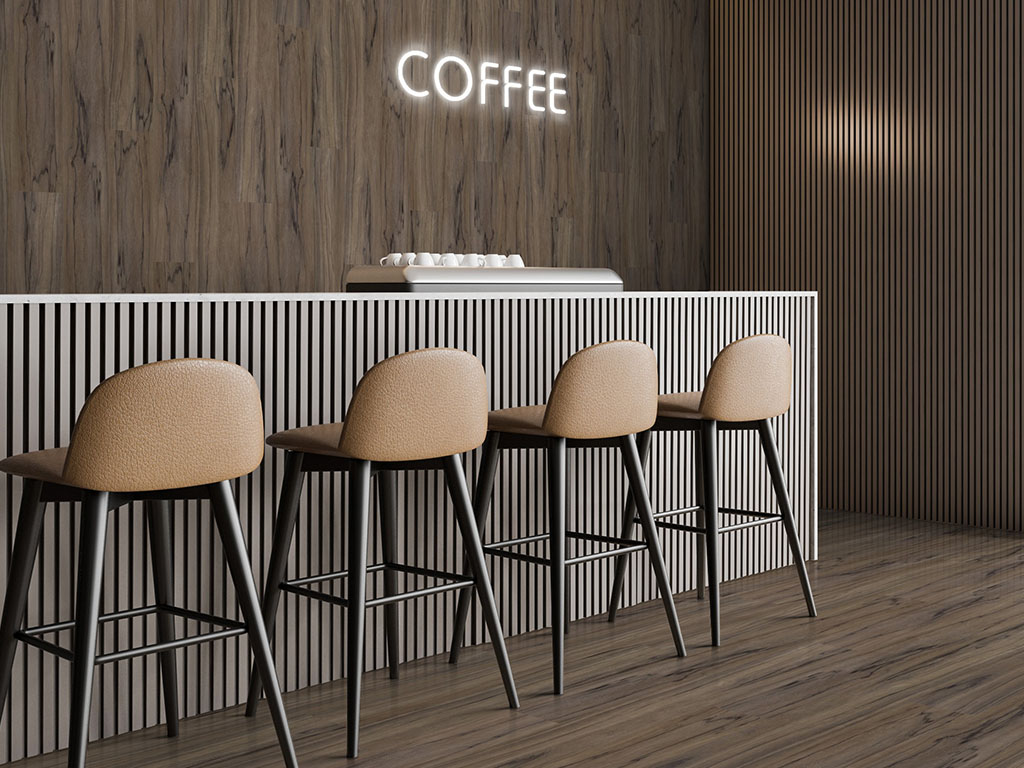
Retail Store Design Trend #4: Acoustic Considerations

Acoustic design is an increasingly important aspect of retail environments, aiming to enhance customer satisfaction and employee comfort. As retail spaces become more experiential and customer-focused, controlling sound plays a crucial role in creating the desired atmosphere and improving overall functionality.
- Enhancing shopper experience: A well-managed acoustic environment can significantly elevate the customer experience. It helps minimize distractions, allowing shoppers to focus on their purchasing decisions in a more relaxed setting.
- Employee comfort: For employees, a space with controlled acoustics reduces stress and increases productivity. This is particularly important for staff who spend long hours on the sales floor.
- Integrating with design elements: Acoustics seamlessly integrate with other design elements, such as LVT flooring, which offers sound-absorbing properties. This is especially beneficial in busy retail environments with constant foot traffic and background noise.
- Sound zones: Creating different sound zones within a retail space can cater to varying acoustic needs. For instance, areas requiring quieter settings can utilize materials that absorb sound, whereas more lively sections can be designed to enhance ambient sounds.
LVT flooring is an excellent choice for improving acoustics in retail spaces. Its composition helps in reducing sound transmission, making it softer underfoot and more comfortable for both customers and employees. This feature, combined with its aesthetic appeal and durability, makes LVT an ideal choice for retail spaces looking to optimize their acoustic environment.
How to Incorporate Retail Design Trends in 2025
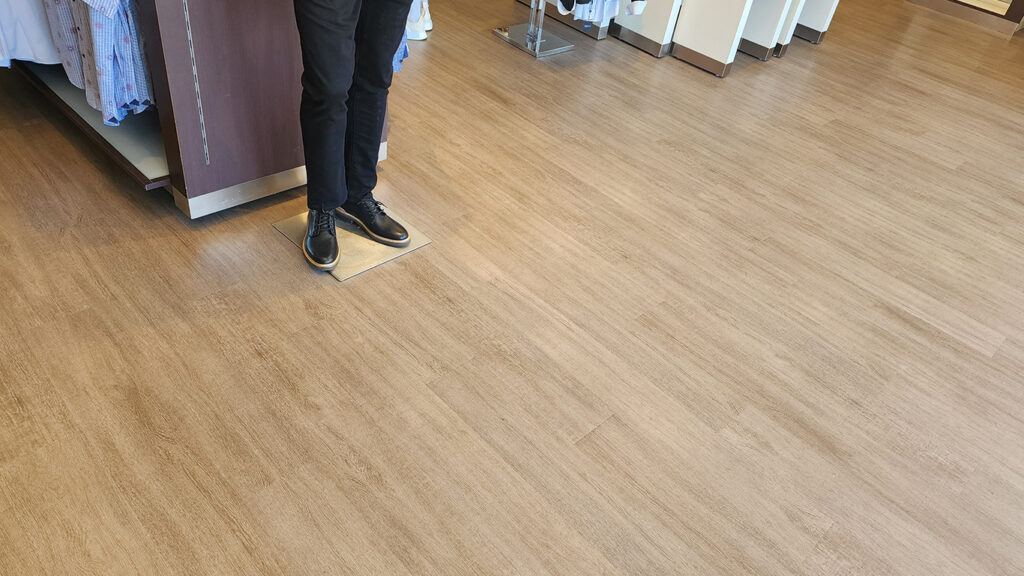
Adapting to the latest retail design trends involves strategic planning and thoughtful execution. Here’s how retailers can integrate these trends effectively while considering budget constraints, target audience, and other key considerations:
- Budget: Adapting to new trends doesn’t always mean a complete overhaul. Prioritize elements that offer the most significant impact, like versatile flooring solutions such as LVT, which provides a fresh look without extensive costs. Assess which changes will yield the best return on investment and plan accordingly.
- Target audience: Each design decision should align with the preferences and expectations of your target audience. Understanding the demographic and psychographic profile of your customers can guide the selection of design elements that resonate with them. For instance, younger audiences might appreciate a store with sustainable materials and biophilic elements, while more affluent customers might look for a luxurious and sophisticated design.
- Collaboration with manufacturers: Working closely with manufacturers, especially flooring providers like TAJ Flooring, can open up possibilities for custom solutions that fit your specific needs. These collaborations can lead to innovative designs that align with current trends while keeping costs in check.
- Incorporating trends without a full redesign: Subtle changes can sometimes significantly refresh a retail space. Consider integrating elements of current trends, such as adding biophilic design touches or reorganizing the store layout for flexibility, without undergoing a complete redesign. Using LVT flooring, for example, can redefine the space and align with several trends such as sustainability and flexible layouts without the need for an extensive renovation.
Successfully incorporating these trends requires a balance between aesthetic appeal, functionality, and financial feasibility. By focusing on key elements and making incremental changes, retailers can stay current with modern trends while maintaining a sustainable and effective retail environment.
The Next Chapter in Retail Store Design

Today’s retail design trends are all about creating spaces that are visually captivating, functional, and adaptable. Whether through bold textures, biophilic elements, or flexible layouts, luxury vinyl flooring solutions provide the perfect foundation for staying on top of these trends.
Ready to explore how vinyl flooring can transform your retail space? Find Your Rep today!





